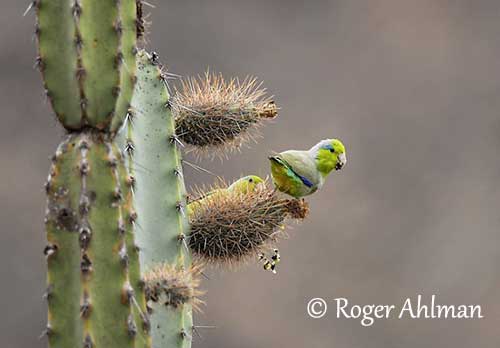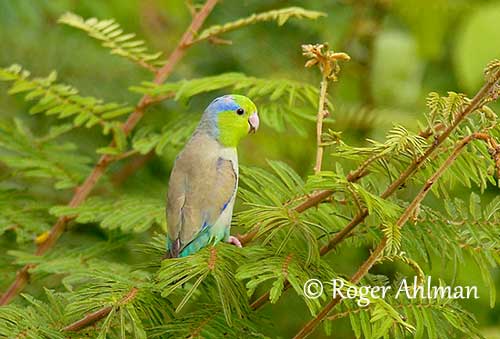
Fr : Toui céleste
Ang : Pacific Parrotlet
All : Himmelsperlingspapagei
Esp : Cotorrita de Piura
Ita : Pappagallino del Pacifico
Nd : Blauwe Muspapegaai
Sd : stillahavssparvpapegoja
Photographers:
Roger Ahlman
Pbase Galleries Peru and Ecuador & My bird pictures on IBC
Jean Michel Fenerole
Photos d’Oiseaux du monde
Text by Nicole Bouglouan
Sources :
HANDBOOK OF THE BIRDS OF THE WORLD vol 4 by Josep del Hoyo-Andrew Elliott-Jordi Sargatal - Lynx Edicions - ISBN: 8487334229
PARROTS OF THE WORLD – An Identification Guide – by Joseph M. Forshaw – Princeton University Press – ISBN 0691092516
BIRDS OF PERU by Thomas S. Schulenberg, Douglas F. Stotz, Daniel F. Lane, John P. O’Neill, Theodore A. Parker III – Princeton University Press 2007- ISBN: 978-0-691-13023-1
Neotropical Birds – Cornell Lab of Ornithology
THE AVIANWEB - Beauty of Birds (Sibylle Faye)
Wikipedia, la enciclopedia libre
Pacific Parrotlet
Forpus coelestis
Psittaciformes Order – Psittacidae Family
INTRODUCTION:
The Pacific Parrotlet is a Neotropical species, a small, green Psittacidae resident on the Pacific coast of Ecuador and NW Peru. It frequents a wide variety of habitats, and especially arid lowland scrub and semi-open tropical deciduous woodland. It nests in holes, in natural cavities or man-made supports.
The Pacific Parrotlet is common throughout its restricted range, in spite of pet trade and changes in the habitat. The species is not currently threatened.

DESCRIPTION OF THE BIRD:
Biometrics:
Length: 13 cm
Weight: 24-28 g
On the upperparts, the Pacific Parrotlet adult male has greenish-grey mantle, upper back and lesser wing-coverts to scapulars and inner secondaries. Lower back and rump, primary and secondary coverts, outer secondaries and bases of inner primaries are cobalt-blue. The short tail is green.
The green underparts are tinged grey on flanks and breast sides. On the underwing, lesser coverts and axillaries are cobalt-blue. The undertail is dull green.
On the head, forehead, crown, cheeks and throat are bright yellowish-green, forming a well-defined facial pattern. There is a blue post ocular stripe merging into the blue-gray hindcrown, nape and neck sides.
The bill is horn-coloured. The eyes are brown. Legs and feet are pale brownish-pink.
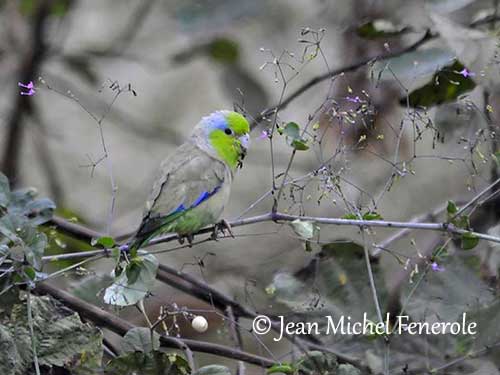
The adult female lacks blue on wings, replaced by emerald-green. There is a blue to bluish-green wash from rear eye to nape and on the rump. The facial mask is greener, less yellowish. The underparts are uniformly green.
The juvenile resembles female but it has green upperparts and mostly green head. The young male has bluish-green rump.
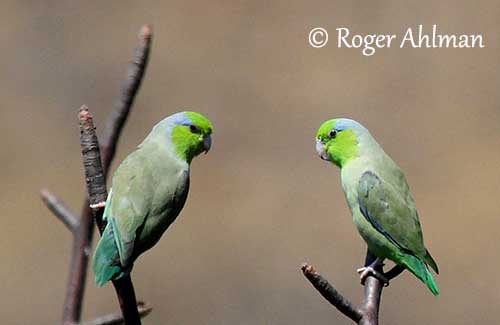
RANGE:
The Pacific Parrotlet is found in W Ecuador (W Esmeraldas) to NW Peru (La Libertad, Cajamarca). This species was recently recorded in extreme SW Colombia (Nariño).
HABITAT:
The Pacific Parrotlet is found in a variety of open to semi-open habitats, desert scrubland, deciduous forest and semi-open woodland, gallery forest, plantations, farmland, urban parks and gardens. It may occasionally frequent humid vegetation, up to 1500 metres, but it is usually found below 800 metres, and locally up to 2000 metres of elevation.
CALLS AND SONGS: SOUNDS BY XENO-CANTO
The Pacific Parrotlet gives high-pitched, passerine-like “tzit” or “zidit” both perched and in flight. These calls are rapidly repeated to produce a loud chattering when several birds are flying together and calling continuously.
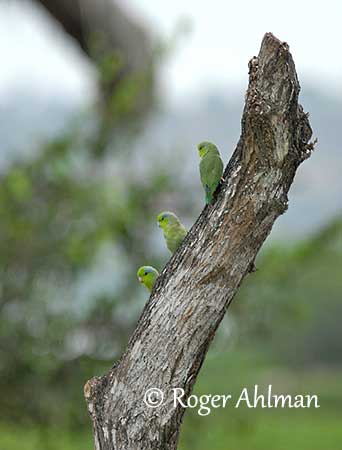
BEHAVIOUR IN THE WILD:
The Pacific Parrotlet feeds on berries, cactus and fruits of Tamarindus. It also feeds on seeds taken on the ground, and other plant material.
They are usually in groups of up to 20 birds, sometimes more outside breeding season. They climb about trees while foraging for fruits and seeds.
Large flocks can be seen at clay-licks where they drink water and eat clay with other parrot species.
See the article: Parrots and clay… an old story !
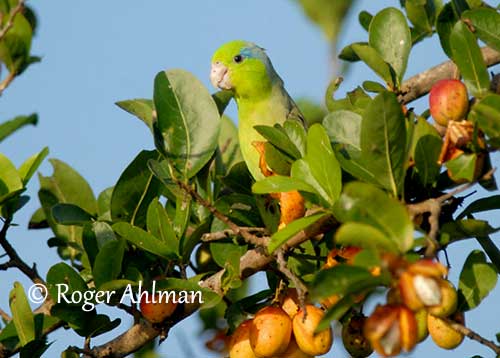
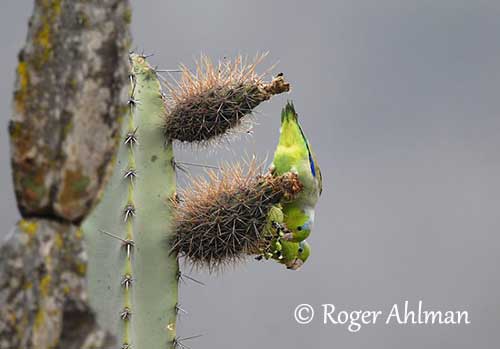
At the beginning of the breeding season, some displays can be observed during pair formation. During these displays, the blue rump is enhanced by adapted postures.
Once paired, the female looks for an empty cavity in tree or man-made support. She cleans the hole, removing any debris and sometimes enlarging the cavity for the clutch. She may use old nests abandoned by other bird species, including old mud nests of Furnariidae. But she may also use a hole in fencepost or other man-made structure.
The Pacific Parrotlet is resident in its restricted range.
It tends to move over short distances, and the flight is fast, with shallow wingbeats.
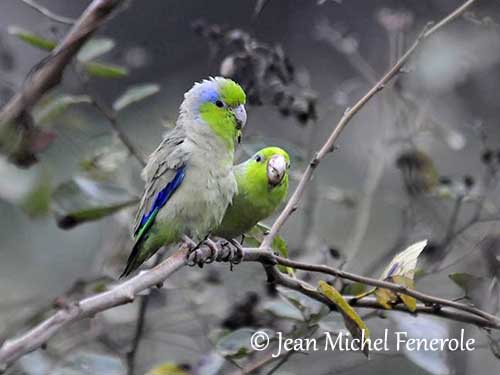
REPRODUCTION OF THIS SPECIES:
The breeding season takes place between January and May in Ecuador.
The Pacific Parrotlet nests in cavities, both natural and artificial ones, or in old nests abandoned by other bird species.
The female selects the nesting cavity and cleans it, but she adds nothing, no lining.
She lays 4-6 eggs on the bare floor of the hole, and incubates alone during 17-19 days while the male protects her and the nest.
Both parents feed the chicks that fledge about 4-5 weeks after hatching.
This species may produce a second brood, about 7-8 days after fledging.
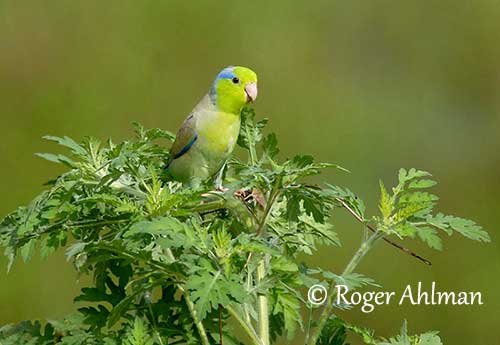
PROTECTION / THREATS / STATUS:
The Pacific Parrotlet is generally common and even locally abundant, mainly in drier areas where they are most numerous. This species is well adapted to habitat change, and is apparently able to withstand strong agricultural and urban developments. It also takes advantage from deforestation and expands its range in areas with remnant vegetation, so long as some trees are left.
The Pacific Parrotlet is not globally threatened and the population is suspected to be stable. It is currently evaluated as Least Concern.
